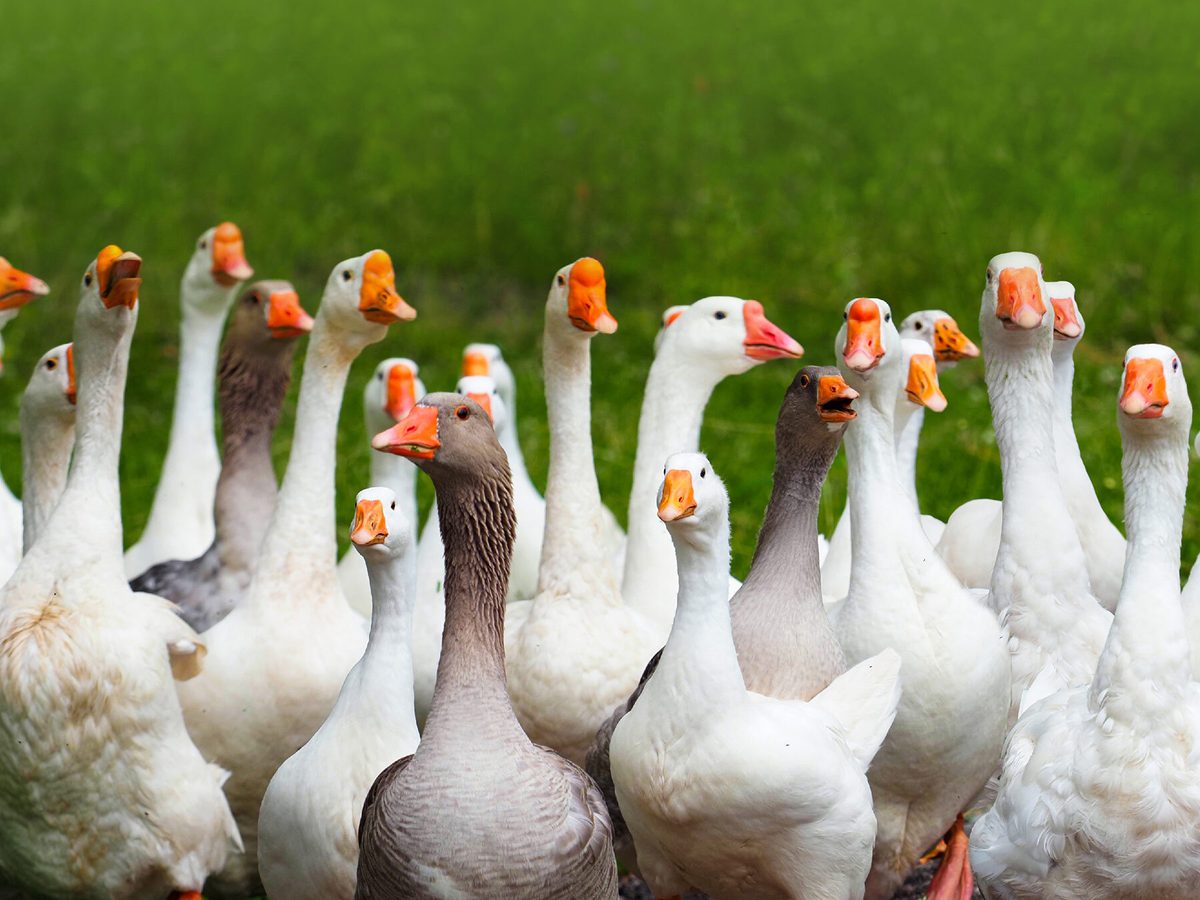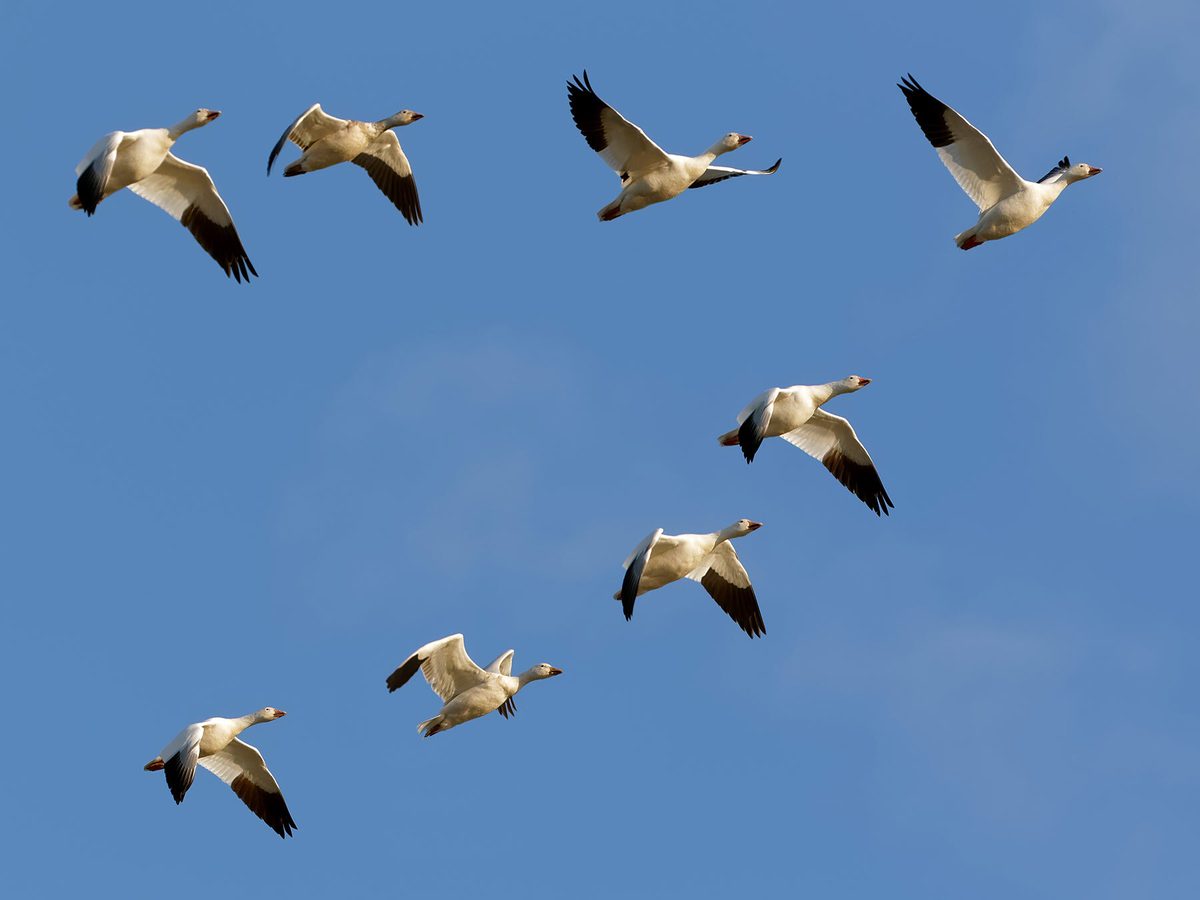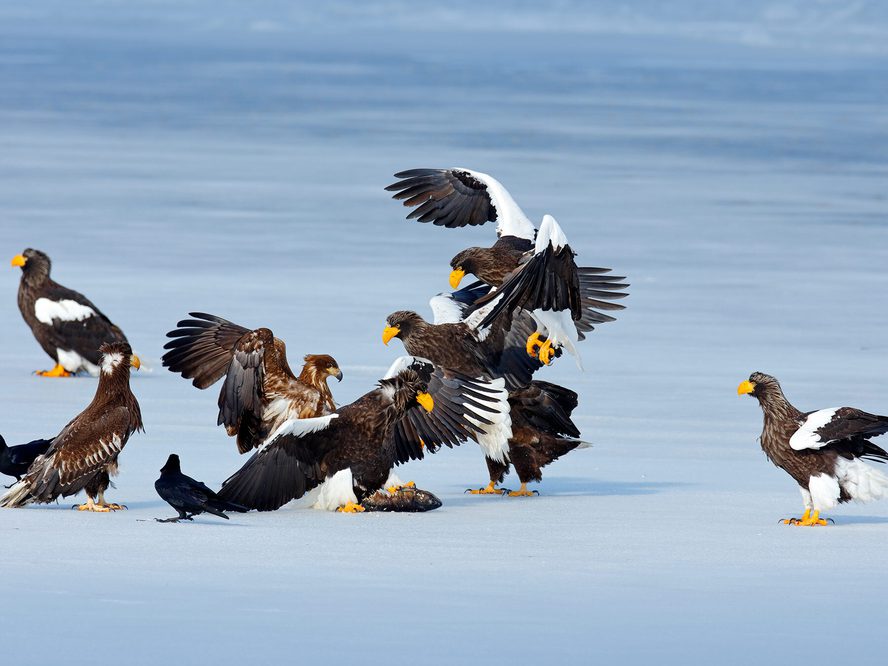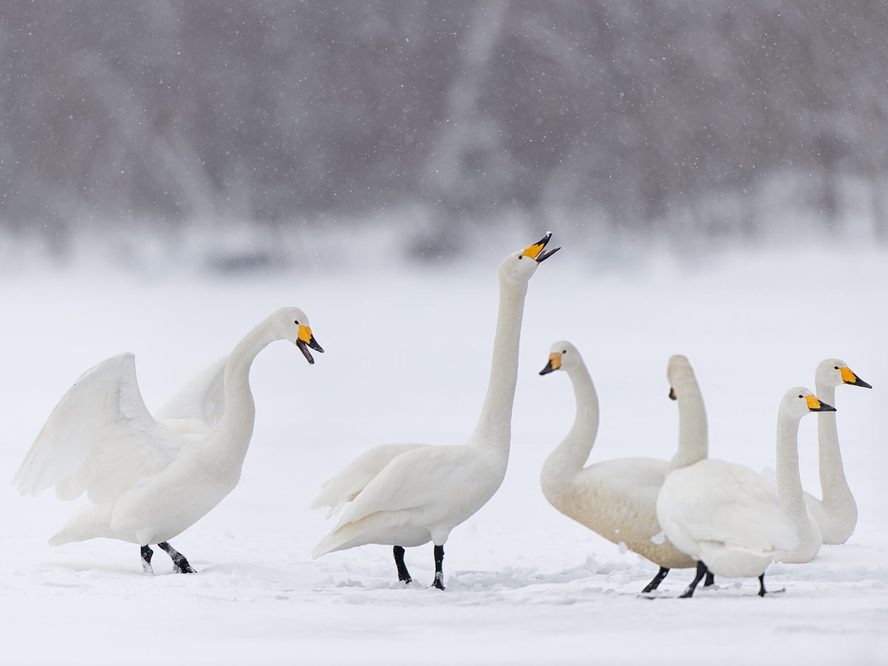Jump to Section
Collective Nouns for Geese: What's the Official Terms?
Last updated: 18 December 2023

Most geese are generally gregarious birds who form flocks during migration and outside of the breeding season. If you've seen a flock of geese, you may already know that they can be rather noisy, but that is the collective noun for a group of geese?
Geese have many different collective nouns, which change depending on where they are.
- For example, when on the ground or in the water, they are often referred to as a gaggle of geese.
- In flight, a group of geese is called a skein, team or wedge.
- On the water or flying close together, a wedge of geese.
- The most generic term that can apply to geese anywhere is a flock.
Continue reading as to why a group of geese got some of these wacky names, more information about flocks of geese, and the complete list of names.

A group of migrating snow geese flying together
Other names for a group of geese
- a bunch of geese
- a chevron of geese
- a christmas of geese
- a cluster of geese
- a covert of geese
- a drove of geese
- a flight of geese
- a gagelen of geese
- a gagelynge of geese
- a herd of geese
- a knob of geese
- a knot of geese
- a lag of geese
- a little knot of geese
- a nide of geese
- a nye of geese
- a plump of geese
- a sord of geese
- a string of geese
- a sute of geese
- a trip of geese
- a "V" formation of geese
What is a flock of geese in flight called?
When geese are flying together in groups, they are called either a flock, team or skein. If they are flying in a tight formation, close to one another, they can be called a wedge.
The term 'skein' is probably the most interesting one, as it's thought to have come from the word 'skein', which means a measure of yarn. This term is thought to be given to certain birds in flight (geese, swans and waterfowl) as they can often look like a piece of wool or yarn in the sky when flying in their formations!
Why a wedge?
When geese are flying in a tight 'V' formation, their shape can look like a wedge that you'd put under a door to force it to stay open. Which is the simple reason they are referred to as a wedge of geese when in the air.

A wedge of geese
Why do geese fly together in groups?
It's relatively common to see a skein of geese flying together in a "V" shaped formation. When you see this happen, it generally means that the geese are migrating with their 'family' and are travelling to another location.
Often geese will join up with other families, and it can even sometimes mean that there are hundreds and even thousands of geese migrating together; now that's a sight!
Flying in flocks comes with many benefits. The main benefit is that flying in these groups and formations makes flying much more efficient for geese, which means they can fly further.
This is because each goose flies slightly above the bird in front of them, which reduces the resistance of the wind, meaning they conserve their energy better.
Geese mostly have two homes, one which they spend time during the winter and another for the summer. The majority of geese will flock and migrate to the south during the winter and the north during the warmer months.
Canada Geese are one of the exceptions to this and will travel in the opposite direction. This means they migrate south during the warmer months and back north during the colder months.
The majority of female geese will return to the same place each year to build nests and raise their young. This place is often the same place where they hatched themselves and will continue for their entire life - which can be as long as 35 years; however, the average lifespan is around 21 years.
Group Name in Water
On the water, the collective noun for a group of geese is a plump.
There is a common misconception that when geese gather on the water, that they are searching and hunting for fish, which is not correct.
One of the reasons you'll see geese plunging their heads below the surface is for food, but they're generally feeding on the aquatic plants that are found below the surface of the water.

A flock or wedge of Canadian Geese on the water
Why A Gaggle
A group of geese together on land is called a gaggle simply because when they are together in these large groups, they often get rather noisy and rowdy.
The other definition for the term gaggle is a 'disorderly group of people', which can apply to geese in these large groups. The loud noise they produce can mean they can become rather disorderly, aptly earning them the name!
How many geese are required for a gaggle?
Generally, to qualify as a gaggle, there needs to be at least five geese in the group.
What is a group of baby geese called?
The most common collective noun given to a group of baby geese is a brood of goslings. This can be combined with other terms, such as a gaggle of goslings or a flock of goslings.
Other generic bird terms such as nestlings or fledglings can also be used; however, goslings is the most common.

Egyptian Goose with many goslings
When do geese flock together?
Geese tend to form large groups when the breeding season is over. After the breeding season, they become much more social and gather in places rich with food sources.
The flocks are maintained for migration, and birds will stay together for the entire journey.
Although they are generally okay with being around one another, they may compete with each other with displays and fights, particularly in places where food is less abundant.
Why do geese flock together in large groups?
The main reasons geese form large flocks are for faster foraging of food, protection from predators, and during migration.
Foraging together in these large groups means they can all take advantage of the same food supplies. This is typical behaviour by species such as the pink-footed goose, who can regularly be found foraging together.
Protection from predators is another benefit of forming these large flocks. This is because there are more birds to look out for trouble nearby and can be quick to alert the rest of the congregation about any potential threats.
Predators can have a much harder time hunting for geese when they are in large groups as well, as they can often be overwhelmed by the number of 'targets' to catch, often meaning they get confused and won't get any!
One of the downsides to forming these large flocks is the noise that is produced. Because geese are rather noisy birds, when you put many of them together, this noise is multiplied and can mean predators have a better chance of tracking them down.

A large group of Canadian Goose gathered on a frozen lake
FAQs
How many geese are in a flock?
There isn't a definitive answer to this, as it can vary, but generally speaking, it takes five or more geese together to be considered a flock or any other collective noun.
What is a pair of geese called?
There is no specific term for a pair of geese; however, they are mostly referred to simply as a pair of geese.
The name for a male goose is a gander, and a female goose is sometimes referred to as a dame; however, females are usually just a goose or geese (plural).
Geese Species Specific Terms
- The two most common terms for a group of snow geese are an avalanche and a blizzard.
- There are two specific collective nouns for a group of barnacle geese; an encrustment and a hull.
- A group of bean geese are known as a pod.

A pair of barnacle geese flying together













